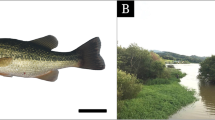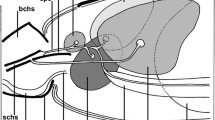Summary
The paired maxillary nephridia of Polyxenus lagurus were studied by light and electron microscopy.
-
1.
Each maxillary nephridium is subdivided into three segments, viz. lateral sacculus, tubule and duct.
-
2.
The sacculus has the shape of a flattened pyramid. Tendons, mostly of collagenic fibers, are attached to its edges. The sacculus is stretched at the sides of the head capsule between occiput and gena by muscles inserting at the tendons.
-
3.
The cells of the sacculus are flattened and enclose a wide lumen. They represent typical podocytes with basal pedicelli, and contain numerous pinocytotic vesicles and other vacuoles.
-
4.
The cells of the coiled tubule bear at their luminal surface a fringe of microvilli. Their bases are characterized by many infoldings. Numerous mitochondria and transparent vacuoles are situated between the folds. Due to the infoldings the nuclei are located in the apical portions of the cells. Here also many lysosomes and lipid droplets occur. Septate desmosomes are frequently differentiated between adjacent tubule cells.
-
5.
At the distal part of the gnathochilarium the tubule transforms into the outleading duct. Both ducts terminate separately close to the median body plane in front of the sense bolsters of the gnathochilarium. No cuticular intima of the lumen can be found. This finding corresponds to the theory of the mesodermal origin of the duct as well as of the whole nephridium.—The results are compared with published data on the structure of nephridial organs in the head of other arthropods.
Zusammenfassung
Die paarigen Maxillarnephridien von Polyxenus lagurus wurden histologisch und elektronenmikroskopisch untersucht.
-
1.
Jedes Maxillarnephridium ist in drei Abschnitte untergliedert: in den lateralen Sacculus, den Tubulus und den Ausführkanal.
-
2.
Der Sacculus ist flach und dreieckig. Jeder Ecke sitzt eine Sehne an, die vor allem aus kollagenen Fasern besteht. An den Sehnen inserieren Muskeln, die den Sacculus an den Seiten der Kopfkapsel zwischen Occiput und Gena ausspannen.
-
3.
Die Sacculuszellen sind flach und umschließen ein weites Lumen. Sie stellen typische Podocyten mit basalen Pedicellen dar. In ihnen finden sich zahlreiche pinocytotische Vesikel und andere Vakuolen.
-
4.
Die Tubuluszellen tragen nach dem Lumen zu einen Mikrovillisaum. Ihre Basen sind vielfach eingefaltet. Innerhalb der Falten liegen zahlreiche Mitochondrien und transparente Vakuolen. Die Nuclei werden durch die Einfaltungen in den apikalen Zellbereich gedrängt. Hier finden sich auch Lysosomen und Lipidtropfen. Zwischen benachbarten Tubuluszellen sind häufig septierte Desmosomen ausgebildet.
-
5.
Der Tubulus geht im distalen Abschnitt des Gnathochilarium in den Ausführkanal über. Beide Ausführkanäle münden getrennt paramedian von den Sinnespolstern des Gnathoohilarium nach außen. Ihre Lumina sind nicht mit einer kutikularen Intima ausgekleidet. Wie das ganze Maxillamephridium ist auch der Ausführkanal mesodermalen Ursprungs. — Das Maxillarnephridium von Polyxenus lagurus wird mit cephalen Nephridialorganen anderer Arthropoden verglichen.
Similar content being viewed by others
Literatur
Altner, H.: Die Ultrastruktur der Labialnephridien von Onychiurus quadriocellatus (Collembola). J. Ultrastruct. Res. 24, 349–366 (1968).
Bruntz, L.: Sur la présence des reins labiaux et d'un organe phagocytaire chez les Diplopodes. C. R. Acad. Sci. (Paris) 136, 57–59 (1903).
—: Contribution à l'étude de l'excrétion chez les Arthropodes. Arch. Biol. (Paris, Liège) 20, 218–221 (1904).
—: Les reins labiaux et les glandes céphalique des Thysanoures. Arch. Zool. exp. gén., 4. Sér. 9, 195–238 (1908).
Fahlander, K.: Die Segmentalorgane der Diplopoda, Symphyla und Insecta Apterygota. Zool. Bidr. 18, 243–251 (1939).
Groepler, W.: Feinstruktur der Coxalorgane bei der Gattung Ornithodorus (Acari, Argasidae). Z. wiss. Zool. 178, 235–275 (1969).
Haupt, J.: Zur Feinstruktur der Labialniere des Silberfischchens Lepisma saccharina L. (Thysanura, Insecta). Zool. Beitr., N.F. 15, 139–170 (1969a).
—: Zur Feinstruktur der Maxillarnephridien von Scutigerella immaculata Newport (Symphyla, Myriapoda). Z. Zellforsch. 101, 401–407 (1969b).
Kümmel, G.: Das Cölomsäckchen der Antennendrüse von Cambarus affinis Say. Zool. Beitr., N.F. 10, 227–252 (1964).
Reinecke, G.: Beiträge zur Kenntnis von Polyxenus. Jena. Z. 46, 845–896 (1910).
Seifert, G.: Die Entwicklung von Polyxenus lagurus L. (Diplopoda, Pselaphognatha). Zool. Jb. Abt. Anat. u. Ontog. 78, 257–312 (1960).
Tiegs, O. W.: The embryology and affinities of the Symphyla, based on a study of Hanseniella agilis. Quart. J. micr. Sci. 82, 1–225 (1940).
Tyson, G. E.: The fine structure of the maxillary gland of the brine shrimp, Artemia salina: the end-sac. Z. Zellforsch. 86, 129–138 (1968).
—: The fine structure of the maxillary gland of the brine shrimp, Artemia salina: the efferent duct. Z. Zellforsch. 93, 151–163 (1969).
Author information
Authors and Affiliations
Additional information
Herrn cand. rer. nat. Günther Horstmann danken wir herzlich für seine freundschaftliche Hilfe beim Einarbeiten in die elektronenmikroskopische Technik.
Rights and permissions
About this article
Cite this article
El-Hifnawi, E.S., Seifert, G. Über den Feinbau der Maxillarnephridien von Polyxenus lagurus (L.) (Diplopoda, Penicillata). Z. Zellforsch. 113, 518–530 (1971). https://doi.org/10.1007/BF00325669
Received:
Issue Date:
DOI: https://doi.org/10.1007/BF00325669




